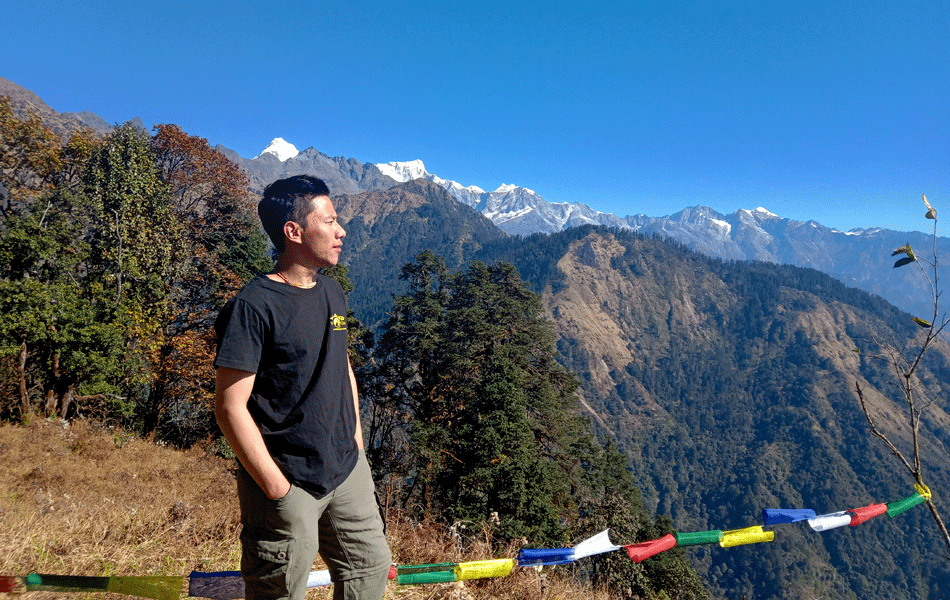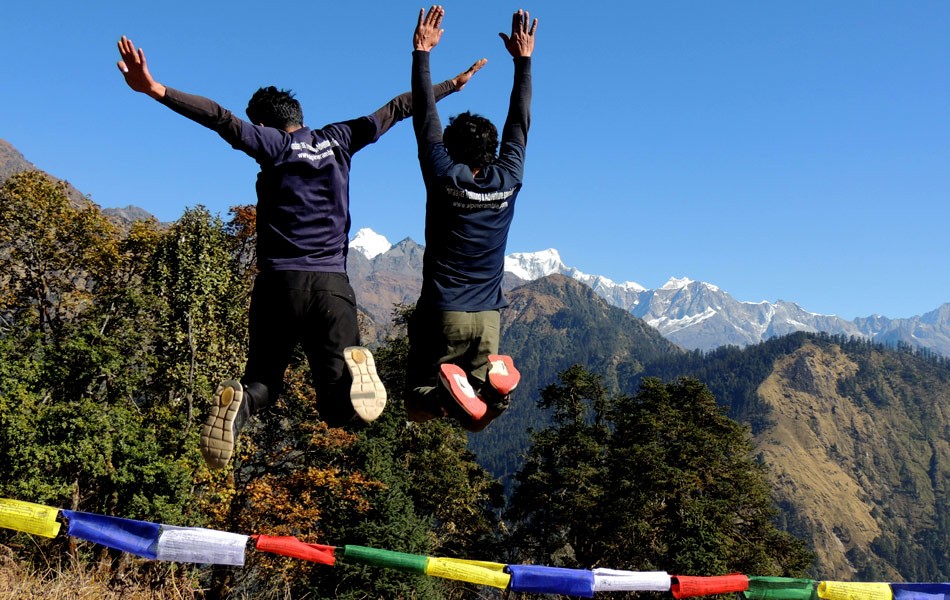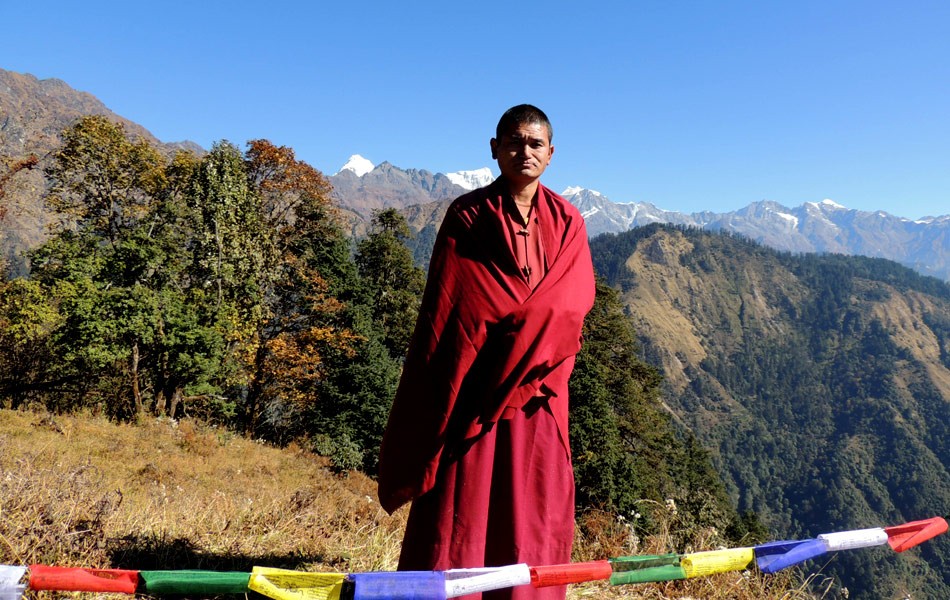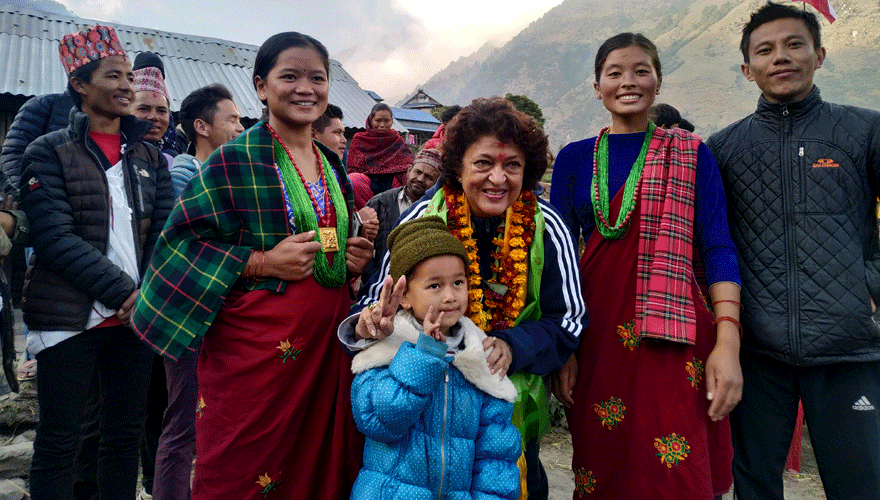
The Ruby Valley Trek is one of the most beautiful home-stay treks in Nepal. It is a much easier and shorter trek than any other high altitude treks in Nepal. However, this trek incorporates diverse terrain, culture, and wildlife throughout the journey along with the most spectacular and close up mountains view of Ganesh Himal, Langtang, and Manaslu ranges. Furthermore, In Spring, the Ruby valley decorates with many beautiful flowers including Rhododendron-the national flower of Nepal as well as many others like Pines, Orchids in the background. The summer and Autumn are slightly different to trek in this region as this season is quite challenging in terms of cold in the winter and shower-rain in the summer seasons but this time is less crowded which might be the perfect season if you like avoiding the crowded while trekking in the Himalayas.
An epic journey toward the most stunning places of the Himalayas within Ruby Valley offers the most beautiful views and it’s a landscape of the Himalayas, however, you will get to learn about people of different ethnicity, lifestyle, and traditions especially Gurung and Tamang people when visiting those fascinating villages during the trip. Likewise, the iconic sunrise view over the Himalayas is a vantage point that could be experienced in almost every single village of the region.
If you are looking for this amazing Ruby Valley home-stay trekking journey at the best time to enjoy this trek fully then choose the best season of Spring and Summer. However, Nepal has four major seasons including Spring, Summer, Autumn, and Winter, amongst them Spring and Summer are the best seasons for trekking to Ruby Valley.

Moreover, hot spring in the Ruby valley is another main highlight of this trek whereas travelers can have a very relaxing time with a great showering experiencing and very relaxing and healing for the aching muscles.
The Ruby Valley has been freshly welcoming trekkers from all over the world to experience the world’s most unique and unspoiled home-stay trekking experience through the highest mountains of the world.
Trip Highlights
-
Spectacular and close view of Ganesh Himal, Langtang, and Manaslu
-
Hot springs
-
Explore the Traditional and lifestyle of Gurung and Tamang
-
Exotic flora and fauna
-
Visit fascinating Buddhist monasteries, Gompa, and Temples.
When is the Best time to do Ruby Valley Trek?

To enjoy the trip, You need to find the best seasons of the year. However, you can go on Ruby Valley Trek any time of the year. Yet, the monsoon is not an appropriate time in terms of the rain. There is heavy rainfall during the evening or night but the dark clouds are ever-present. During this season, it appears no good views also there are a few tackles that you need to face like leeches, mosquitoes, possible landslides, and slippery roads, etc. However, this is the time when animals are most active and freshness makes them more beautiful. If you are a keen biologist, then monsoon is best for you with no doubt.
Here are the lists of the 4 seasons such as
-
Autumn (September to November)
-
Winter (December to February)
-
Spring (March to May)
-
Summer/Monsoon (June to August)
Autumn is perfectly one of the best times to do this trek in Nepal. Autumn (Fall) is a dry season that offers clear blue sky and moderate temperature and it’s suitable for trekking that’s why this is the best time to go on any treks in Nepal including Ruby Valley, this is the way this season brings a lot of crowded into the popular treks like Everest and Annapurna regions.
Ruby Valley trek can also do during December, the dry air and clear sky with the best visibility will stay the same as Autumn but December is the starting month of winter, during winter, it will be quite colder than other mo months and will snow sometimes, If you are planning on trekking in December, then make sure you better prepare with appropriate packaging gears.
Spring is the best time to do trekking in Nepal. This season offers a clear sky with great views as the trail will bloom with red and white rhododendrons and many other exotic flowers found in this region, a good time to go on any treks in Nepal.
Ruby Valley Trek Route Itinerary

Getting on this trek, There are at least 2/3 different routes that you can trek to Ruby Valley. The itinerary that you can choose it based on your time length and interest.
The trail can go straight to the Annapurna Base Camp or take a detour to Ghorepani Poon Hill or take a smaller detour to Ghandruk or both. You can make the climbing stop and returning stop at different villages. Of course, taking different routes causes plus or minus 3-4 days.
Here are 2 suggested itineraries that go to Ruby Valley, one of these trails goes through PangsanG Dada – the highest point of the region it is also called Pangsang pass situated at an altitude of 389 meters above sea level. In general, the trek starts from Kathmandu and ends at Kathmandu via Dhading Besi.
Itinerary
|
Day |
Activity |
|---|---|
|
Day 1 |
Kathmandu to Syaprubesi (By local Jeep/Bus) |
|
Day 2 |
Trek from Syaprubesi to Gatlang village |
|
Day 3 |
Trek from Gatlang to Somdang |
|
Day 4 |
Trek from Somdang to Tipling via Pasang |
|
Day 5 |
Trek from Tipling to Chalisa |
|
Day 6 |
Rest day at Chalish Gaun |
|
Day 7 |
Trek from Chalsih to Khading |
|
Day 8 |
Rest Day at Khading |
|
Day 9 |
Trek from Khading to Dundure |
|
Day 10 |
Drive back to Kathmandu by local jeep/bus. |
Trekking Permits and Costs for Ruby Valley
To trek to Ruby Valley, you need two trekking permits.
-
One is the Langtang national park permit.
For SAARC nationals: Nrs.1500 (about US $13)
For Others: Nrs.3000 (about US $29)
-
Second is the Trekkers’ Information Management System (TIMS) card that costs NRS. 1000 (about US $10)
Trekking Equipment (Gear Lists Required)
Trekking equipment is one of the most important factors when you are trekking in the mountain, having proper gears means you are goo at trek without any troubles. However, If you are wondering about what to pack for the trek then here are the lists of trekking gears in general what you should carry while trekking to Ruby Valley.
-
A lightweight waterproof trekking sue/ boots. - make sure that your shoes are well-fitting, light, and comfortable enough to make your trip worth it.
-
A few pairs of liner socks. Take some extra pairs for a warm climate and two pairs for a cold climate. Hiking/ liner socks are better.
-
Some pairs of underwear. Carry some pair of underwear from home.
-
A warm down jacket – Ultralight packable down jacket – if you do not want to carry then you can also rent in Kathmandu fora few dollars.
-
Trekking T-shirts and trousers – make sure to bring some good hiking trekking t-shirt and trousers
-
some pairs of thermals
-
A light and warm sleeping bag. If you do not prefer for a long use then no worries, You can either buy or rent in Nepal before go on a trip.
-
Trekking pole. - if you haven’t had any trekking before then take a pair of walking poles as it helps you to make your stamina well during the trek of ups and downhills.
-
Few pairs of Gloves. Take at least 2 pairs of gloves one from warm and thick and another one is the liner.
-
Sunglasses
-
A warm hat
-
First aid kit including Diamox and Oral Rehydration Salts, etc.
-
Toiletries
Note: Above the lists of gear will help for the Everest base camp trek and Annapurna base camp trek as well,
Some Frequently Q&A
Here are some of the frequently asked questions answered to provide a clearer picture of Ruby Valley Trek for those travelers who are initially planned to hike in the region.
1) What is the highest altitude of this trek that we reached?
The highest altitude we will reach in this trek is 4910m. This is the elevation of Pangsang dada which is the highest pass of the region as well.
2) How long we should walk every day when doing Ruby Valley Trek?
This trekking route is very gentle and required at least 4-5 hours of walk on an average per day. However, someday might be a bit longer day than usual due to cross the highest pass like Pangsang.
3)How fit do I need to be to do the Ruby Valley trek?
Ruby Valley trek is a Grade C or An easy home-stay trekking route, So, any average fit person can do this trek without any tackles of difficulties. even if you do not have any previous experience that’s okay you are finding for this trek, in-fact, this trek doesn't require any previous trekking experience and strong physically and mentally.
4) Do We get a place for battery charging and hot shower facilities?
Yes, You can charge batteries en route as well as a hot shower by buckets. For this, you need to bring your own plugging charger adapters tools. You may not need to pay for them.
5) Are there ATMs on the way to Ruby Valley?
No. There are no ATMs on this route of Ruby Valley. You need to be prepared for all the cash for your trekking tour either in Kathmandu or Syaprubesi/Dhading Besi. All the cash that you will be withdrawn must be in rupees.
6) Do we get any internet access?
Some places yes, but there are no WIFI facilities on this route, so you can be used the data by local SIM car. Remember, the Internet by local Sim can be slower.
8) How much do guides and porters cost?
If you are taking an experienced local trekking guide it costs $20-25/ day and $15-218 per porter including foods, hotels, insurance, trekking equipment for the local guide and porter.
Tipping is the traditional way of Nepalese people, so every guide and porter do expect good tips after their great performances, However, there is no set amount as tipping is a westerner created culture. They will be happy to receive what you see fit to give based on their work and your satisfaction after the trip. In addition to this, If you feel confused, trekkers have taken 15% of the total payment as the standard for the guides and porters.
If you have any other questions you like to inquire upon, please comment below or contact us. We would love to answer your queries in the best possible way.
Food and Accommodation on Ruby Valley Trek
The foods on this trek are quite cheaper than in other regions of Nepal but you get very basic foods at the local lodges or home-stay during the trek. Staying at home-stay means you are not using any fancy hotels or lodges so you will be spending your time like a normal local lifestyle during the trek and you don’t really need to be paid for your overnight stay at the home-stay in this region but if you pay them a little amount of money it will directly help to the community or person who is living a difficult life in the mountain. The rooms in the home-stay might have some private or sharing a dormitory with a normal bed or a dorm room with 3-5 beds. They are small but cozy and tidy with a good view.
For the food, you will be likely taken your food to the same place where you stay as locals expect you to eat where you stay. Home-stay owner/ local gets some money on food rather than a lodging. However, for the food, There are no different food options you can choose from the Menu as you choose to stay at a normal tea house. The common foods on this trek have eggs prepared in different ways, chapatti- bread, potatoes prepared in different ways, packet noodles, Dal Bhat Tarkari and local meals prepared by as an own traditional way. Moreover, Dal Bhat is a typical /traditional meal of Nepal that can be found in this region very easily at the best price. filling option. For drinks, you can have Nepali tea, black coffee, etc.
The budget, $15-24 per day on average will cover three meals, with the lodge on this trek. However, if you like to take some alcohols you will find them easily either western brands or local for this you, you need to take some extra cash for the alcohols. But alcohol is not recommended at the high altitude area due to the less oxygen level.
What is AMS?

AMS is short of Acute mountain sickness, Acute mountain sickness (AMS) is the effect on the body of being in high altitude areas. AMS is common at high elevation and it can be suffered by anyone traveling over 2000m or above. However, our body normally responds to the lower air pressure and a lower concentration of oxygen at high altitude areas.
The symptoms, You likely feel a headache, nausea, vomiting, lack of appetite, shortness of breath, etc. If anyone of you is having these symptoms then you must be taking care of yourself and you can’t ignore them at all, it might be dangerous at some points. Rather, it will only get worse and turn into fatal conditions HAPE or HACE. if you do not take proper concern and medications on it. You need to take proper rest and ascend downhill. To make this go away.
To prevent the best thing to do in case of AMS is to stop ascending. No more climbing to the high areas. Turn back and descend or stay in the same elevation for some time and see how it reacts to you if you don’t feel better in a while then you are suggested to get back to the hospital immediately at a lower elevation. However, medications like Diamox also helps in acclimatizing or preventing high altitude sickness.
Ruby Valley trek takes you over 3900m. So, it is still very important to adopt preventive measures like staying hydrated, eating well, ascending slow, etc while trekking on the mountains.
Useful Tips for Ruby Valley Trekking
If you are ready to set on a trek to Ruby valley then here are some suggestions that may be of help for you while trekking.
- Take a good carbohydrate or protein meals set like Dal Bhat Tarkari, bread, and soup, etc, Dal bat set is more common and you can have more or add more at the same price, it is also called “one price more rice- Dal bat power 24 hour”
- Carry enough cash in Rupees with you for the trekking tour since there are no ATM facilities.
- Add some extra days just in case if you want to extend your trip more in nature with these beautiful mountains and its landscape.
- Aware of the people while traveling, not every people has the same way of thinking and prosperity. Bad people can be anywhere around the world. Trust your guide and ask them whatever you want to know, ask your guide, and interact with him more than other individual ones.
- Rent some of the most expensive trekking gear if you do not have your own like a Down jacket/ sleeping bag or trekking pole etc. you can rent them very easily in Kathmandu through the trekking agency or trekking tours.
- Public display of affection is not welcomed and wearing revealing dresses will earn you unwanted criticism. Make sure to bring some long clothing to cover your whole buddy or at least bell to legs and bells to neck.
- Ask always the people before taking the picture of them or places while standing in front of the,m
- Foods might take a little longer to cook. Order earlier.
Conclusion
Hope this helps in deciding on and planning out your trek to Ruby Valley Region, God bleed you, and wish you all the very best!
Planning a Trip to Nepal and Need help?
Tell us about your trip to Nepal and what you expect from it. We will be happy to answer your questions within 24 hours and help you design a trip with a comfortable itinerary to best meet your needs at any time!



